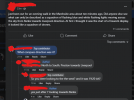Another sighting on Reddit, this time in New Mexico. Unfortunately no date or time information with these, but it shows that people are still seeing them and still being confused.
Source: https://www.reddit.com/r/UFOs/comments/18w276b/help_strange_lights_in_new_mexico/?share_id=imaFqZyKrxHwL37S3kW3R&utm_content=1&utm_medium=android_app&utm_name=androidcss&utm_source=share&utm_term=1
Source: https://www.reddit.com/r/UFOs/comments/18w276b/help_strange_lights_in_new_mexico/?share_id=imaFqZyKrxHwL37S3kW3R&utm_content=1&utm_medium=android_app&utm_name=androidcss&utm_source=share&utm_term=1

